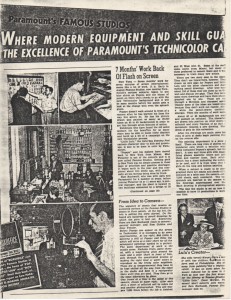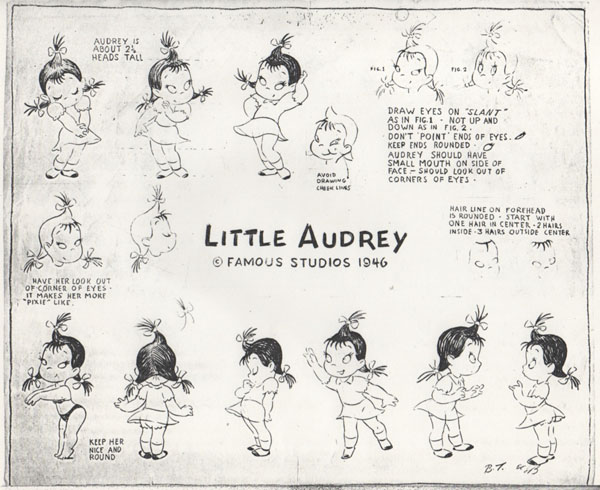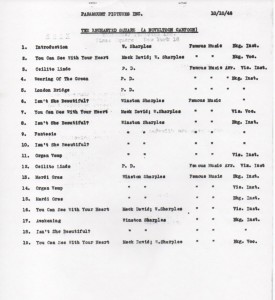
More Noveltoons! The 1946-47 season brought about eight Noveltoons which broke down into three “Screen Songs”, one (still lost) “Snuffy Smith” cartoon, a “Herman & Henry”, a “Blackie”, and two musical specials – “Raggedy Ann” in The Enchanted Square and the Leprechauns in The Wee Men.
The Wee Men is an interesting film. Bill Tytla must have been getting restless, needed to spread his wings, and Famous gave him a chance to apply some of his Disney magic in an almost 10-minute epic. The Leprechan characters are almost (but not quite) a knock-off of the Seven Dwarfs, and an original “Whistle While You Work” song (the future Screen Song theme, “Start The Day With A Song”) – and the use of the littlest Leprechaun, “Laddie” “Patty”, on posters and advertising materials hints that Famous was hoping this would become a popular series (though only one sequel was produced in 1949).
Little Lulu Dept.
I don’t know what this was exactly – its a bad xerox of two pages (a brochure?) that reprints a page out of Box Office Magazine from 1943(?) about Famous Studios new set up in New York. Click to enlarge the pages and maybe you can make out Tom Golden, Dave Tendlar, Sam Buchwald, Bob Little and others. If anyone can track down a clearer version of this, please send it this way.



And what of Little Lulu? This publicity still (above), made from cels and backgrounds from Chick and Double Chick (1946), was issued in 1947 may be nice, but her cartoons were running out of fresh ideas (Cad and Caddy, A Scout With The Gout, Loose In The Caboose, even the titles were all sounding the same). There was one highlight this season: the imaginative Musicalulu. The cue sheet and the film are embed below.
The Lulu cartoons were not as successful was Paramount hoped. Creator Marge wasn’t pleased with the films herself. Famous had Bill Tytla draw up this “understudy” for Lulu – Little Audrey – in late 1946 (for a cartoon that would appear in late 1947, Santa’s Surprise).

Sales Dept.
Showmen’s Trade Reviews has this two page article on the top shorts of the 1946-47 season. It again shows the three tier popularity of Paramount’s Popeye, Speaking of Animals and Puppetoons. Also note the completely inaccurate telling of Bugs Bunny’s origin in the same piece.
Fred Hift has another point of view in Box Office Magazine as he ranks all shorts together (live and animated). For some reason, Terrytoons and Disney poll most popular (Really? I don’t think so.).
Music Dept.
And finally this week, a few more cue sheets from cartoons released during 46-47. The Enchanted Square was remastered by Steve Stanchfield for his highly recommended Noveltoons disc.


(thanks to Don Yowp)






 Jerry Beck is a writer, animation producer, college professor and author of more than 15 books on animation history. He is a former studio exec with Nickelodeon Movies and Disney, and has written for The Hollywood Reporter and Variety. He has curated cartoons for DVD and Blu-ray compilations and has lent his expertise to dozens of bonus documentaries and audio commentaries on such. Beck is currently on the faculty of CalArts in Valencia, UCLA in Westwood and Woodbury University in Burbank – teaching animation history. More about Jerry Beck [
Jerry Beck is a writer, animation producer, college professor and author of more than 15 books on animation history. He is a former studio exec with Nickelodeon Movies and Disney, and has written for The Hollywood Reporter and Variety. He has curated cartoons for DVD and Blu-ray compilations and has lent his expertise to dozens of bonus documentaries and audio commentaries on such. Beck is currently on the faculty of CalArts in Valencia, UCLA in Westwood and Woodbury University in Burbank – teaching animation history. More about Jerry Beck [



































Pairing Tytla as director with the other ex-Disneyite, Al Eugster, as head animator on “The Wee Men” showed Famous was really trying for some strong personality characterizations in this one (and the work on the threatening expressions of the Miser, especially when he catches Patrick, look like nothing else Famous Studios ever did).
The Lulu shorts featuring her against an adult male authority figure were still enjoyable, right up to the final entry in the series, “The Dog Show-Off”. The problem was the episodes without that didn’t really have a strong conflict to work with and that made them a bit on the bland side (though at least the dream sequences, as in “Musica-Lulu” or “A Bout With A Trout” were more imaginative and less formalistic than the dream sequences would quickly become in the Little Audrey series).
I recall enjoying “A Bout With A Trout” myself, though I also liked “Bored of Education” as well simply for the interaction with Tubby. I would say the best of the ones involving her with the adult pointy mustached authority figure would have to be “Bargain Counter Attack”.
Agree on “Bargain Counter Attack”, which came out of the Nick Tafuri/Myron Waldman unit. The key to the Lulu cartoons from that unit was it allowed it to indulge in it’s penchant for ‘cuteness’ — going all the way back to the Pudgy series — but having an adult male meant they could mix that cuteness with the far more physical slapstick gags that audiences of the 1940s (and the 2010s) preferred. The unit also did “The Dog Show-Off” and had success with the musical cartoons, like “Musica-Lulu” and “A Bout With a Trout” because even there, Lulu had an anti-authority edge that played well off the dream sequences.
Once Lulu was gone, the Waldman unit rarely found the proper balance again, even though their Casper series was the most successful of Famous’ ‘in-house’ creations (and that still doesn’t mean the unit couldn’t do good cartoons if they took a harder edge — “Winner By A Hare” was one of the more memorable one-shots that led to a continuing series, even though most TV markets tended to edit out the end gag).
The one thing that struck me about “The Wee Men” was that the villain had a full complement of fingers.
At Rnigma
The villain also looks like something Go Nagai will make (going by that still shot in the You Tube video before you play the video really makes it blunt), years before he entered the industry.
It wouldn’t surprise me they would give him that many fingers at all (I suppose it’s an interesting contrast to the simpler 4-fingered type the leprechauns get anyway, it sorta reminds me of Snow White and noticing how all the normal humans get 5 but the dwarfs only 4).
Go a couple of seconds after the freeze-frame in the YouTube clip and look at the miser’s face as the camera trucks in on it after he’s captured Patrick. Not quite a Disney-level close-up on a villain in terms of the power of the characterization and the menace, but really, as close as any non-Disney studio would ever get in the short subjects, and you’d have to assume the credit for that goes to Bill Tytla.
The villain in the leprechaun cartoon looks like one of those simian Irishmen seen in 1870s Thomas Nast drawings:
http://s23.postimg.org/rt85958aj/image.jpg
Of course, black people were treated with less respect in the popular media; still this sort of thing must have made a few audience members grit their teeth.
Also, those “click to enlarge” images are a pain – can’t you just embed them full size?
Also the villian from Wee Men was also featured in a Casper the Friendly Ghost cartoon (Spooking With A Brogue) where Casper went to Ireland and helps out Billy Brown (a short lived character who was featured is several Casper cartoons in the late 1940’s). Caspeer assists Billy {speaking in a Irish Brouge} and his mother in saving his home from a ruthless miserly landlord [in which Billy Brown mistakes Casper as a Leprechaun] – and when the miserly landlord sees Casper than thinks that Casper was a Banshee (A evil spirit from Irish folklore).
The same miser also appears in the sequel “Leprechaun’s Gold” from 1949, alongside a little girl who helps Patty out who looks like an Irish doppelganger of Little Audrey!
“Leprechaun’s Gold” was an early portent to Famous’ problems in the 1950s — namely, taking a successful one-shot cartoon and trying to do follow-ups with the same character(s), but coming up with story lines that are almost carbon copies of the original.
Famous’ one-shots in general were pretty good, right up to the end of the 1950s, and even after that, with the Irv Spector-Eddie Lawrence shorts — but even in the 1960s, where the first couple of Swifty & Shorty efforts (as Ralph & Percy) had some really good verbal wordplay, but once they made it a continuing series they struggled to find new material.
Peter writes:
Actually no – not if you want to be able to see them/read them clearly.
For example in this post, the magazine article text is just too small to read legibly with the 600 pixel wide limit I have on these pages. And though the cue sheets I could post and you’d be able to read them, it would make the post itself huge and quite long – and that’s not the way I’d like to see it.
So “click to enlarge” … is that really so hard for you to do?
I find in my travels that there are still quite a large number of people that are that net-illiterate Jerry. It is hard explaining these things to them.
The Noveltoons set is one of Steve Stanchfield’s best. I hope he does a second volume.
Funny… I was considering purchasing that set over the weekend. Several shorts linked to or mentioned in today’s post are on that set. It’s enticing…
Related, it’d be nice to have all the Lulu’s in a set (or the Audrey’s for that matter).
Boy, completely inaccurate is an understatement there. Not a single correct thing was said in that history of Bugs by a very wide margin. Strange how the writer got got both dates mixed up by two years (1936 should be 1938 and 1938 should be 1940). I’m thinking the writer was actually giving that “history” entirely out of his own foggy memory of watching the early Bugs/rabbit cartoons.
Actually, there is one exception–The only correct thing mentioned was that the early Hardaway rabbit was indeed minor at the time and essentially forgotten by the general public until it got retooled into Bugs.
Santa Surprise is one one of my favourite Little Audrey cartoons with Jackson Beck (as the singing voice of Santa Claus) and Mae Questel as Little Audrey. The plot was about and her friends (representing Harlem NY & Hawaii ((which was a territory before becoming the 50th state a few years later)) [USA], Spain,The Netherlands and Russia {known then as the Soviet Union} stowing away in Santa’s sleigh and as a Christmas gift helping tidy up his workshop.
Also the sequel of The Wee Men was a Screen Song known as The Emerald Isle (1949) featuring the song McNamara’s Band based on the popular song back then.
Santa Surprise is one one of my favourite Little Audrey cartoons with Jackson Beck (as the singing voice of Santa Claus) and Mae Questel as Little Audrey . The plot was about and her friends (representing Harlem NY & Hawaii ((which was a territory before becoming the 50th state a few years later)) [USA], Spain,The Netherlands and Russia {known then as the Soviet Union} stowing away in Santa’s sleigh and as a Christmas gift helping tidy up his workshop.
Can’t blame Famous for at least trying something a little different there with highlight kids from different lands (long before the whole multiculturalism became the norm).
Also the sequel of The Wee Men was a Screen Song known as The Emerald Isle (1949) featuring the song McNamara’s Band based on the popular song back then.
There’s that as well, but I’m sure Jerry was thinking of this.
https://www.youtube.com/watch?v=B0PKRgD02mk
“Snuffy Smith” is reeeeeeally a surprise! And here I thought the only ones were those GOD awful 60s King Features atrocities!!!
Check out Jerry Beck’s brilliant article on “the secret history” of Little Audrey. https://cartoonresearch.com/index.php/the-secret-history-of-little-audrey/
I’ve always considered “The Enchanted Square” one of Famous’s very best cartoons, if not THE best.. The story is solid, the sentimental angle is both subtle and honest, the music is excellent, and the overall production design is outstanding. Notice that only in her dream do “Billie’s” eyes have irises in their pupils. The involvement of (always distinctive) background painter Shane Miller in the story work no doubt contributed to the impressionistic transformation of Shanty Square into a fairytale landscape. (The brief scene of “glowing organ pipes” is an effect that looks years, even decades, ahead of its time.) And Jackson Beck’s reading of that last speech can’t be beat. If this cartoon doesn’t “get” you, check for a pulse…
Amen to that! I just love that cartoon.
There’s a lot to be said about this one. I recall feeling sad when Billie imagined what her mother looked like, that was quite a tender moment to have there.
Interesting to think the highlight of this season are two shorts with a sort of Irish theme to them, more so with “The Wee Men”, given it’s Irish settings (or Scenics), though I like the idea of highlighting Irish immigrants and descendants trying to make a living in the New World as “The Enchanted Square” shows the tough, urban environment many had to endure during those hard times.
I see someone already corrected you Jerry on the little leprechaun’s name (Patty), so I don’t need to say much there (I was going to, even his 121th birthday was too obvious).
I think the first time I saw this and it’s 1949 follow-up, was a tape out out by Goodtime’s “Kids Klassics” label in the mid 80’s, which for some reason chose to cut the first few minutes of “The Wee Men” so I never saw the intro and song at all as it opened up right when Patty was shown the hidden crock of gold, right after the opening credits. It was an odd move but I suppose given how long this was, they had to do something to fit it on a 25-30 minute tape (they let “Leprechaun’s Gold” alone though, the other two cartoons spotlighted was the Castle Films print of “Woody Plays Santa Claus” and another Lantz toon “Pantry Panic”).
What I will say is how obvious “The Wee Men” served as a possible springboard for a potential series had they pushed Patty and his youthful aventures further. Had that happen, I suppose we would’ve seen this carried on into the 50’s and even see Patty show up in comics published by Harvey for decades to come (probably stuck in the same fantasy forest Casper’s in).
One interesting by-product was the reuse of the leprechauns’ song “Start Your Day With A Song” as the title theme for the later Screen Songs, (Or were they Kartunes by then? I’m only familiar with the Harvey prints…)
The Screen Songs used it too.
Kartunes used “Sing A Song of Sixpence” over the opening titles.
https://www.youtube.com/watch?v=QmPEmCYQf-s
(For some reason part of the opening titles of a Harvey print of a Kartune were tacked onto the first cartoon on all the Casper VHS tapes released by MCA Universal in the 1990’s. The other 3 cartoons on the tape started with the title card, but still replaced Casper’s theme song with a Kartune’s opening title music.)
(For some reason part of the opening titles of a Harvey print of a Kartune were tacked onto the first cartoon on all the Casper VHS tapes released by MCA Universal in the 1990′s. The other 3 cartoons on the tape started with the title card, but still replaced Casper’s theme song with a Kartune’s opening title music.)
Not having seen those tapes, it’s interesting they did that at all. Watching videos people have stuck of that on YouTube, I see those same tapes also used the syndicated “Casper & Friends” end credits as well, which also seem out of place to me too (thankfully these cartoons were spared the new audio tracks they created for that show).
I remind myself more of the WorldVision tapes that had this as-is quality about them where the video starts with the one opening for the first cartoon and each short was edited to remove the openings and endings of every one until the very end when we have the Harveytoons logo show up. It’s like they just spliced up a reel and send it to the transfer house and be done with it.
Thank you. I find this subject refreshing.
The Enchanted Square is easily one of Famous Studios’s best cartoons. Visually, it’s amazing to look at, ESPECIALLY in a restored print. The two writers, Orestes Calpini (animation director) and Shane Miller (background artist), obviously did their very best to make a cartoon worthy of being called “Disneyesque”, and I mean that in the best possible way.
Fun fact: It was the only one of the three Raggedy Ann cartoons of the 1940s to be done in New York instead of Miami.